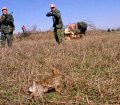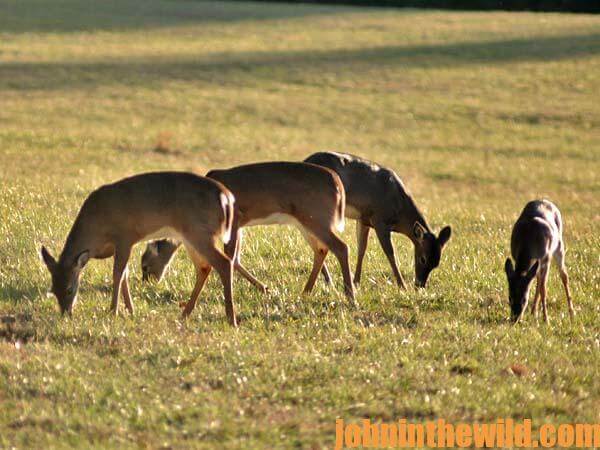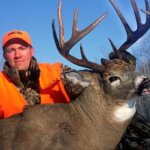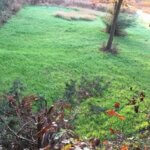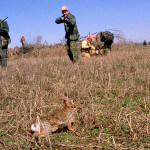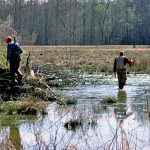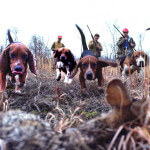John’s Note: Now’s the time in February that outdoorsmen particularly enjoy hunting rabbits, especially with their families, neighbors and friends. Rabbits, like all other wild species, must have a combination of ample food and proper cover to survive. If an area loses either one, bunnies just can’t flourish. Throughout much of the nation, farming practices have changed. The small-plot family farm generally either has been abandoned or replaced with big-field farms, which are not conducive to rabbit hunting. So, where can a fellow go to find a mess of bunnies? The answer’s quite simple: anywhere you find an abundant food source and cover to protect the rabbits. Let’s see if we can define some rabbit-food hot spots and learn how to hunt them.
Rabbits and deer feed on many of the same grasses and shrubs.
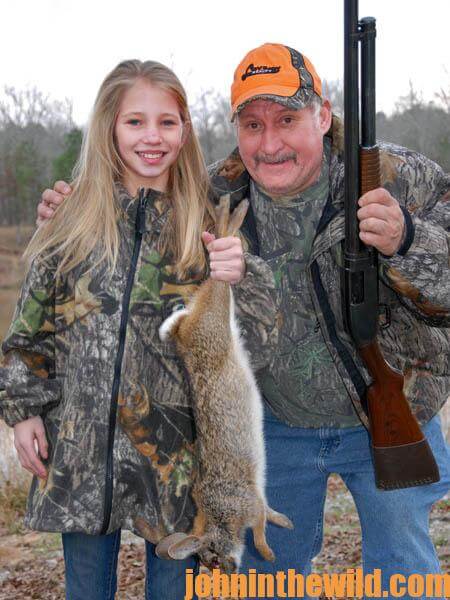 Although deer primarily browse and eat brushes, shrubs and young trees, deer also like tender green shoots of grass. The rabbit will eat almost any type of leaves or grass that grows. Oftentimes where you find ideal deer habitat, you’ll discover productive rabbit hunting there too. Sitting on the edge of a green field at White Oak Plantation near Tuskegee, Alabama, a couple of years ago, I watched 15 deer feeding just as night fell. With my binoculars, I scanned the green field looking for the trophy buck that a hunter often would find on the edge of a field when shooting light was almost gone. Although I didn’t spot my dream buck, I did see large numbers of rabbits coming from the woods and going into the green fields. I realized the rabbits didn’t know this green field was planted for deer and probably thought it was planted for them. When I arrived back at camp that night, I talked with Robert Pitman, the owner of White Oak, about the possibility of hunting rabbits around his green fields at the end of deer season. When we did hunt, we found the bunnies abundant, as I had believed we would.
Although deer primarily browse and eat brushes, shrubs and young trees, deer also like tender green shoots of grass. The rabbit will eat almost any type of leaves or grass that grows. Oftentimes where you find ideal deer habitat, you’ll discover productive rabbit hunting there too. Sitting on the edge of a green field at White Oak Plantation near Tuskegee, Alabama, a couple of years ago, I watched 15 deer feeding just as night fell. With my binoculars, I scanned the green field looking for the trophy buck that a hunter often would find on the edge of a field when shooting light was almost gone. Although I didn’t spot my dream buck, I did see large numbers of rabbits coming from the woods and going into the green fields. I realized the rabbits didn’t know this green field was planted for deer and probably thought it was planted for them. When I arrived back at camp that night, I talked with Robert Pitman, the owner of White Oak, about the possibility of hunting rabbits around his green fields at the end of deer season. When we did hunt, we found the bunnies abundant, as I had believed we would.
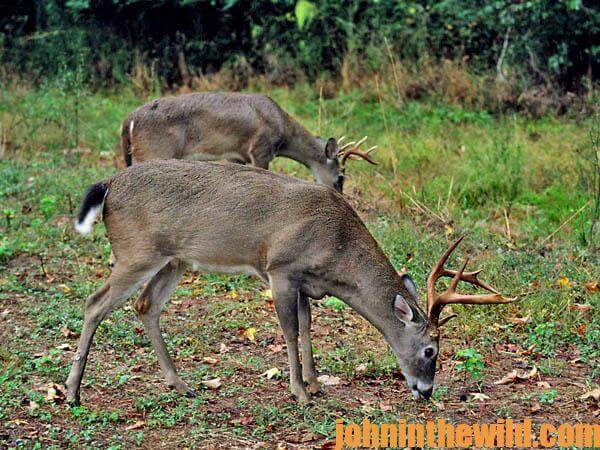 To find rabbits, look on the edges of green fields planted for deer. You often can predict the kind of rabbits you’ll find around these green fields by where the field lies. If the green field is planted in or near a pine plantation or a clear cut, generally you’ll have cottontails to hunt. However, if that planted green field is in swampy terrain or on the edge of a creek or a river, primarily swamp rabbits may utilize that field. You also can pinpoint productive rabbit and deer hunting in the middle of a pine plantation. Often the fire breaks, the wildlife openings and the green fields planted for deer as well as the roads leading around and through the pine plantation will be planted with some type of low-growing grass on which rabbits thrive. Remember, all a rabbit must have to survive is food and cover. If rabbits locate those ingredients in a young pine plantation or on the edge of a pine plantation, that’s where the rabbits will live.
To find rabbits, look on the edges of green fields planted for deer. You often can predict the kind of rabbits you’ll find around these green fields by where the field lies. If the green field is planted in or near a pine plantation or a clear cut, generally you’ll have cottontails to hunt. However, if that planted green field is in swampy terrain or on the edge of a creek or a river, primarily swamp rabbits may utilize that field. You also can pinpoint productive rabbit and deer hunting in the middle of a pine plantation. Often the fire breaks, the wildlife openings and the green fields planted for deer as well as the roads leading around and through the pine plantation will be planted with some type of low-growing grass on which rabbits thrive. Remember, all a rabbit must have to survive is food and cover. If rabbits locate those ingredients in a young pine plantation or on the edge of a pine plantation, that’s where the rabbits will live.
For delicious recipes for preparing rabbits and other wild game with our family’s recipes from the past 45+ years in the outdoors, get John and Denise Phillips’ new eBook “The Best Wild Game & Seafood Cookbook Ever: 350 Southern Recipes for Deer, Turkey, Fish, Seafood, Small Game and Birds.” “Click here to get this book.”
About the Author
John Phillips, winner of the 2012 Homer Circle Fishing Award for outstanding fishing writer by the American Sportfishing Association (AMA) and the Professional Outdoor Media Association (POMA), the 2008 Crossbow Communicator of the year and the 2007 Legendary Communicator chosen for induction into the National Fresh Water Hall of Fame, is a freelance writer (over 6,000 magazine articles for about 100 magazines and several thousand newspaper columns published), magazine editor, photographer for print media as well as industry catalogues (over 25,000 photos published), lecturer, outdoor consultant, marketing consultant, book author and daily internet content provider with an overview of the outdoors.” Click here for more information and a list of all the books available from John E. Phillips.”

